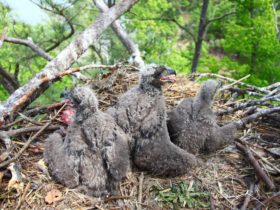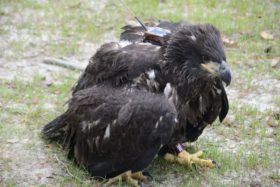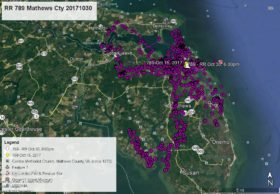Azalea map July 29 – Aug 2
Satellite map July 26-31
July 31, 2009Blog Improvements Coming
August 7, 2009
Categories
 Azalea has again flown over new territory, but also settled into something of a routine. She is spending less and less time near the nest. At night she is roosting at the dump area, but not always in the same tree. She is making morning visits to the nest and afternoon soaring flights over the area. Two new locations during her flights were July 31 at 2:00pm she was over Camellia Shores across Lake Whitehurst (data point to the left on map), and on August 2 at 2:00pm she was over Waterford Apartments near Shore Drive and the northwest edge of Little Creek Reservior (far right data point). During this time there have been no sightings of either HE or HK, and it appears that only one of the adults – female – is still here.
Azalea has again flown over new territory, but also settled into something of a routine. She is spending less and less time near the nest. At night she is roosting at the dump area, but not always in the same tree. She is making morning visits to the nest and afternoon soaring flights over the area. Two new locations during her flights were July 31 at 2:00pm she was over Camellia Shores across Lake Whitehurst (data point to the left on map), and on August 2 at 2:00pm she was over Waterford Apartments near Shore Drive and the northwest edge of Little Creek Reservior (far right data point). During this time there have been no sightings of either HE or HK, and it appears that only one of the adults – female – is still here.




24 Comments
Hello Mr. Lukei, I saw Azalea this morning on a branch near the nest relaxing and calling (for mom?) Has anyone seen her catch food for her self? Is mom bringing food to her? Will she follow mom when she leaves or go off on her own? No sightings of anyone else? I miss them already! I hope they all have a wonderful life and visit again.
NC PATTY – As I write this Azalea has returned to the nest, then branch in nest tree, and now (10:17am) has flown to the camera tree. All the squawking you see her do is called “food begging”. Yes, she is calling for mom, but she really wants mom to bring food. Azalea has not been observed catching her own food. She got fed at the nest at 6:30 this morning. Eagles learn to catch their own food by watching their parents, siblings and other eagles. Azalea seems to be a slow learner and in no hurry to leave home.
Azalea seems to be favoring her left leg, holding it out for long periods of time.
Hello again, I see Azalea is in the nest now She is still calling. She looks like she has a full(crop?) Mom is feeding her or she is hunting for herself.
Mr. Lukei, Do eagles regurgitate pellets like hawks ? If so..there should be some around the nest site…we could see what Azalea has be eating .
NC PATTY – Owls are best known for regurgitating pellets of undigested prey remains, mostly because they frequently swallow their prey whole and the feathers, fur or bones do not all dissolve. Hawks and eagles can also regurgitate a pellet after eating, but not as often. They usually pick their prey apart and eat it in smaller bites, and discard the undigestible parts. That is especially true of eagles whose food is most often fish.
Azalea has not been seen catching her own food, and was provided food at the nest this morning at 6:30 by one of the adult eagles.
Hi Reese 🙂
I am confused. I thought Mom and Dad stayed at the gardens year round and that they were a unique pair for not leaving. Thanks 🙂
Wild Irish – As far as I know, the adult eagles each year have had periods, sometimes weeks long, when they have not been seen at NBG. Don’t know where you heard that they never leave.
Were the other two eaglets ever observed catching their own food?
Margy – I did not get any reports nor did I see either HE or HK catch their own prey.
Is it unusual that the male eagle is not around,but the mother eagle has continued to stay in the area? Do mated pairs spend periods of time apart and then come back together, or does this mean that they have separated permanently?
Thanks Reese for all the info you give us – it has been wonderful watching the eaglecam the past few years, and your updates are great. It is exciting and sad at the same time to see our babies leaving the nest. I hope HK and HE are okay. Is it normal that they’ve not returned to the nest, and should we be worried that Azalea hasn’t begun to feed herself yet?
Marilyn – Breeding pairs of bald eagles in the Chesapeake Bay region usually do not disperse far or for a very long period from their breeding territory. They can leave together, but usually move about separately. In Virginia, three “concentration areas” have been identified where bald eagles go to feed. The closest to NBG is on the James River south of Hopewell. One reason they don’t go far or that one of the adults stays near their breeding territory is to defend it from being taken over by another pair of eagles. In 2008, we saw first hand an attempt by a female adult to move in and take over the NBG nest. What was so surprising about that event, was the very weak defense put up by the nesting pair, especially the female who just left the area, or at least was not seen by any of us for several days. The original pair did return and re-establish their relationship and produce a second clutch of eggs. Bald eagles mate for life, so even if one leaves or they leave separately, they both return to “their” territory to breed again.
REESE,
NOT TO CHANGE THE SUBJECT ABOUT THE EAGLES AT NBG,BUT DO YOU HAVE NESTING OSPREYS AROUND?
KRISTA – Yes there are nesting Osprey here locally and throughout the Chesapeake Bay region. A 1995-96 study by Dr Bryan Watts and Dr Mitchell Byrd of CCB surveyed about 3,500 nesting pair of Osprey in the tidal parts of Chesapeake Bay, and I suspect the population has grown since then. I first got involved with Osprey in 1978 when I assisted in putting up nesting platforms at Back Bay NWR and Mackay Island NWR which at the time had no nesting Osprey. I would estimate that today there are over 200 nesting pair just in the southside Tidewater region of Norfolk, Virginia Beach, Chesapeake, Portsmouth and Suffolk.
The biggest change in nesting location today is that by far most Osprey are building their nests on manmade structures such as cell towers, navigational markers, high power transmission towers and wooden platforms built just for them.
REESE,
I LIVE NEAR CAPE COD MASS AND THEY HAVE QUITE A FEW OF THESE MAN MADE PLATFORMS.WE TRAVEL TO THE CAPE JUST TO SEE THE OSPREYS AND THEY ARE AMAZING BIRDS.WHILE STANDING ON OUR BALCONY AT OUR HOTEL WHICH OVERLOOKS LEWIS BAY WE OBSERVED AN OSPREY (MALE) SWOOPING DOWN AND ATACKING A COYOTE WHO WAS OUT NEAR THEIR NEST DURING LOW TIDE.THEY REALLY DEFEND THEIR NESTLINGS.HE DID CHASE IT AWAY!!!! I WOULD RUN TOO!!!! I ALSO LIVE BEHIND A RIVER WHERE THERE ARE BALD EAGLES ..ONLY A FEW.
Do you think that Azalea’s tracking apparatus has in any way hampered her develpment or has led to her unwillingness to leave the nest and break out on her own?
Marilyn – The satellite transmitter that Azalea is wearing is not interferring with her development or her desire to leave NBG. She is still well within the known period of time that young eagles remain within their natal area. Some have been known to stay as long as 5 months.
CCB is very fortunate to have Libby Mojica on staff. Libby has more experience in fitting transmitters on eagles, especially nestlings, than anyone else in the world, having fitted well over a hundred eagles. Libby fitted the transmitter on Azalea and she follows up with photos sent to her from the webcam. When you see the camera zoom in close to Azalea when she is sitting on a branch, it is not just to give you and I a close-up view, but to give us the opportunity to get a close look and photos of how the transmitter is fitting.
How long will the parents continue to feed Azalea? When the time comes, will they just stop bringing fish to the nest?
Simchah – There is no way to give an exact answer to your question. Azalea fledged 8 weeks ago tomorrow, Aug 8th. One eagle that was satellite tagged last year in Maryland stayed around the nest for 5 months. Azalea seems to be in no hurry to leave home, and as long as one of her parents is willing to provide food, she may stay. Wether she leaves or stays, Azalea is providing us good research data.
If and when the parents stop providing food, will Azalea be able to hunt for her own food? If she stays around the nest and begs for food, and no food is provided, are you planning to provide food?
Ilovelucy – If the eagle parents stop providing food, Azalea will be on her own. We will not provide food. Some eagles do not survive. Will that be the fate of Azalea? There is no way to tell until the time comes.
this is my first year at this eagle cam, didnt know what I was missing, I been a shepherdstown eagle sam watcher for years, I was wondering why the transmitters couldnot track them even after they leave the area, that would really be intresting if we could keep track of them wherever their travels took them.
Kowens – The satellite transmitter WILL continue to send signals after Azalea leaves her natal area (Norfolk Botanical Garden), and will track her where ever she goes for the next three years. Check out some of the other 60 eagles on http://www.wildlifetracking.org that CCB has fitted with transmitters to them and you can see just how far some eagles go and how some stay close to home.